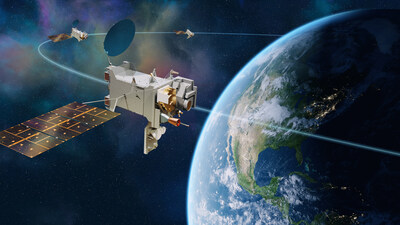Lockheed Martin Selected to Develop Next Generation Weather Satellite Constellation
Rhea-AI Summary
NASA has selected Lockheed Martin (NYSE: LMT) to develop the next-generation weather satellite constellation, GeoXO, for NOAA. The initial contract encompasses three spacecraft, with options for four more, totaling an estimated $2.27 billion. GeoXO will enhance weather forecasts and environmental monitoring, building on the GOES-R series. The satellites will feature advancements in air pollution tracking and marine ecosystem observations. The first launch is planned for the early 2030s, with operations extending into the 2050s. Lockheed Martin aims to leverage its 50+ years of experience and modernized LM2100™ satellite bus technology for this mission.
Positive
- Lockheed Martin awarded a $2.27 billion contract for GeoXO satellites.
- GeoXO mission will extend to the late 2050s, ensuring long-term business.
- New satellite capabilities for enhanced weather and environmental monitoring.
- Leverages Lockheed Martin’s 50+ years of experience in weather spacecraft.
- Use of modernized LM2100™ satellite bus and SmartSat™ technology.
Negative
- Significant financial risk with $2.27 billion investment dependent on successful implementation.
- Potential delays as the first GeoXO launch is not planned until the early 2030s.
Insights
Lockheed Martin's contract with NASA for the GeoXO weather satellite constellation, valued at
Given Lockheed Martin's historical performance in similar projects, their proven track record adds an additional layer of reliability to this contract. The company's prior experience with the GOES-R series highlights their capability to deliver on such high-value projects, reducing execution risk. Investors should see this as a strong indicator of Lockheed Martin's capacity to manage large-scale, complex contracts effectively.
However, one potential drawback is the extended timeline. The first GeoXO launch is planned for the early 2030s, meaning that while the contract is financially beneficial, the actual realization of revenues will be gradual. Investors should account for this in their short-term expectations, recognizing that the major financial impacts will be seen in the long term.
The GeoXO weather satellite constellation offers impressive technical advancements that set a new standard in weather forecasting capabilities. The incorporation of new digital technologies and the SmartSat™ platform ensures that these satellites will be adaptable and upgradable over time. This is a important factor in maintaining the relevance and efficiency of the satellites throughout their lifecycle.
Investors should note the significance of these technological elements, as they imply a lower risk of obsolescence and a higher potential for future enhancements without the need for complete hardware replacements. This not only keeps the operational costs manageable but also extends the functional lifespan of the satellites.
Moreover, the capabilities planned for GeoXO, such as near real-time hyperspectral sounding and enhanced lightning observations, highlight Lockheed Martin's commitment to innovation. These advancements will likely position the company as a leader in environmental monitoring technology, potentially opening up further contracts in both civil and military sectors.
From a market perspective, Lockheed Martin's new contract for the GeoXO satellite constellation enhances its competitive edge in the aerospace and defense industry. The focus on advanced weather forecasting capabilities not only addresses immediate environmental monitoring needs but also aligns with broader market trends towards enhanced climate resilience and disaster management.
This move can position Lockheed Martin favorably against competitors, particularly as governments and organizations globally prioritize climate-related initiatives. The ability to provide real-time, high-resolution data on severe weather and environmental conditions is increasingly valuable and Lockheed Martin's enhanced capabilities could attract additional governmental and institutional partnerships outside of the NOAA contract.
However, the market competition in this sector is fierce and maintaining technological superiority will require continuous innovation and investment. While Lockheed Martin currently has a strong stance, the company must ensure that it continues to advance its technologies to stay ahead of emerging competitors.
NOAA's Geostationary Extended Observations weather satellites to bring new critical measurements and advanced weather forecasting capability
The baseline contract is for three spacecraft with options for four additional spacecraft. The total estimated value of the contract including options is
The GeoXO mission will continue and expand upon critical observations of weather provided by the Lockheed Martin-built GOES-R Series geostationary satellites to include new observations of our oceans and air pollution. GeoXO's new capabilities will deliver more accurate weather forecasting and address emerging environmental issues and challenges that threaten our economy and safety. GeoXO and the nation's weather satellites are vital infrastructure for national resilience.
"Our team is excited and ready to move forward to design and field this critical national capability," said Kyle Griffin, vice president and general manager of Commercial Civil Space at Lockheed Martin. "Our GeoXO design draws heavily from what we've learned with GOES-R spacecraft over the last 15 years, while incorporating new, digital technologies not only onboard the vehicles but in the design and development of this powerful, weather-monitoring platform of the future."
A Deeper Look into Our Severe Weather, Shifting Climate
GeoXO represents an expansion of our nation's geostationary weather satellite enterprise, its capabilities and continued
With new instruments onboard, the observatories will have a major impact including: the first geostationary observations of our coastal ecosystems that supports resilient coastal communities, near real-time hyperspectral sounding to map the state of the atmosphere, enhanced lightning observations for severe convection monitoring, and continental
A Weather Constellation for the Future
The first GeoXO launch is planned for the early 2030s and will maintain and advance NOAA's critical geostationary observations through the late 2050s.
The GeoXO spacecraft is based on Lockheed Martin's modernized LM2100™ satellite bus, which provides more performance and flexibility for addressing NOAA's mission needs over the coming decades. The platform features SmartSat™ technology that enables new software pushes and capabilities as environmental data needs change over time.
Half a Century, 120+ Weather Spacecraft on Orbit
For over 50 years, Lockheed Martin has built and launched more than 120 weather and environmental spacecraft for our government's civil and military agencies.
The revolutionary GOES-R mission provided the first lightning observations from geostationary orbit, the ability to detect remote wildland fire ignitions, and unprecedented tracking of severe weather that have proven indispensable to the nation and sets a new bar for future expectations from the public, forecasters, and researchers who depend on the geostationary weather mission.
The launch of the fourth and final spacecraft in the series, GOES-U, is scheduled for June 25, 2024 from NASA's
About Lockheed Martin
Lockheed Martin is a global defense technology company driving innovation and advancing scientific discovery. Our all-domain mission solutions and 21st Century Security® vision accelerate the delivery of transformative technologies to ensure those we serve always stay ahead of ready. More information at Lockheedmartin.com.
# # #
![]() View original content to download multimedia:https://www.prnewswire.com/news-releases/lockheed-martin-selected-to-develop-next-generation-weather-satellite-constellation-302176133.html
View original content to download multimedia:https://www.prnewswire.com/news-releases/lockheed-martin-selected-to-develop-next-generation-weather-satellite-constellation-302176133.html
SOURCE Lockheed Martin









